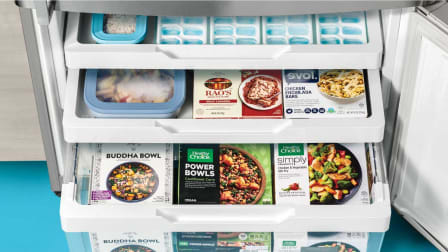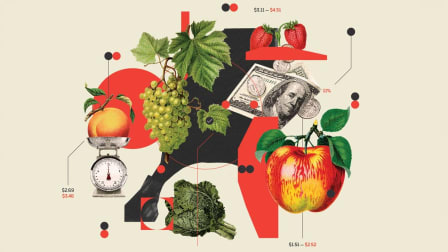15 Ways to Save on Thanksgiving Food Shopping
Holiday grocery shopping is a little bit like Black Friday shopping. You need to plan and shop early to save.

The news on Thanksgiving food prices could spook you like it’s still Halloween.
In its annual Thanksgiving market-basket survey, released Wednesday, the American Farm Bureau Federation estimated that a classic holiday meal for 10 this year would cost a record $64.05. That’s about 20 percent more than last year, and 37 percent more than in 2020.
A 16-pound turkey priced in at $28.95, up 21 percent from 2021. A 30-ounce can of pumpkin pie mix rose by 18 percent to $4.28. Cubed stuffing increased to $3.88, a 69 percent change. Only fresh cranberries, which had a bumper crop year, will cost you a little less.
But here’s the reality: As Thanksgiving grows near, turkey prices are going down. The Department of Agriculture’s Agricultural Marketing Service data shows the average price per pound for turkey has dropped to 95 cents since the Farm Bureau’s “volunteer shoppers” reported $1.18 per-pound prices during their survey weeks of Oct. 18 to 31. As of now, 60 percent of stores are offering sale prices for turkeys, up from 29 percent in late October, the Farm Bureau reports.
“This means consumers who have not yet purchased a turkey should be able to find one at a lower cost,” the trade organization said in a press release.
Bargains Are Still Out There
Bottom line: Grabbing a good—or free—deal on a gobbler is still within reach. As for other Thanksgiving foods, you can use numerous tactics to track down the best prices.
“Thanksgiving is actually one of the most economical meals you can host,” says Annette Economides of Scottsdale, Ariz., who with her husband, Steve, runs the website MoneySmartFamily. The key to saving, she says, is to treat holiday food shopping like Black Friday. Plan ahead, look for sales, and follow common money-saving tips like the ones below.
Turkey-Time Tips
1. Mind the turkey promotions. Check grocers’ circulars and ads for bargains, including free-turkey promotions. Most require you to spend before you can nab the bird.
Go to Consumer Reports’ Holiday Gift Guide for updates on deals, expert product reviews, insider tips on shopping, and much more.
Year-Round Tactics
7. Check the circulars. Planning well to minimize your trips to the store can save you time and reduce your impulse purchases. “If you can save $30 by spending 15 minutes looking at grocery ads, is it worth it?” Economides asks. “I certainly think it is.”
8. Get a store loyalty card. Most grocery chains’ loyalty programs offer special member deals. Some, notably those of Safeway and Stop & Shop, also let you build rewards toward gas purchases at affiliated gas stations.
9. Use shopping apps. A couple we like are Ibotta and Flipp. They both identify manufacturer promotions and coupons, and offer direct rebates after you buy from a participating retailer.
10. Compare unit prices. Unit price shelf stickers under each product can help you better compare prices of like items. But if the store doesn’t have the stickers, download a unit price calculator on your smart phone to do the work for you. We found free ones for both iOS and Android phones.
11. Go with store brands. The cost of store-brand foods and beverages is at least 20 to 25 percent less than name brands of the same product, Flickinger says. (When CR members were surveyed about the grocery stores and supermarkets they liked best, three grocers earned top marks for their store brands: national names Costco and Trader Joe’s, and Central Market, which is based in San Antonio and is a subsidiary of H-E-B.) You can often find store brands right next to comparable name-brand items.
12. Use a cash-back credit card. Some offer rewards for grocery purchases. If you’re looking for a new one, consider the American Express Blue Cash Preferred card; it returns 6 percent on the first $6,000 in groceries purchased at U.S. supermarkets each year, among other benefits. The card is currently offering a $250 rebate for spending $3,000 in the first six months, and the $95 annual fee is waived for the first year. Keep in mind that you may need a credit score of 700 or higher to qualify. The annual percentage rate on this card ranges from 17.74 percent to 28.74 percent, so it’s best to use it only if you pay off your balance each month.
13. Embrace digital coupons. Most grocers will accept manufacturers’ paper coupons, and may even double or triple their value at checkout. Certain retailers do it every day or week; others, less regularly. In the Northeast, Stop & Shop doubles manufacturers’ paper coupons every day. Bi-Lo, in Georgia, North Carolina, and South Carolina, doubles coupons with a value of 60 cents or less every day, unless noted otherwise at the individual store. (At both chains, other restrictions apply.)
14. Use the produce scale. Many veggies are sold by the pound. But if the produce you are buying comes prepackaged and sold for a set price, weigh a few packages. You may find you can get more food for the same price. Keating recently tried that and found one head of organic iceberg lettuce weighing more than ½ pound than another, and a package of organic cucumbers that said it was ½ pound, but was actually nearly 1½ pound. “With natural variation you can stretch your dollar,” Keating says.
15. Buy in bulk. When 10 cans of your favorite soup go on sale for $10, it’s always wise to load up. And larger packages often have lower per-unit pricing. When you go this route, consider donating a portion to a local food pantry. (Or donate cash and let the charity use its larger order size to garner a bigger discount.)
Shop Like a Nutritionist
Eating well isn’t always easy—or fun. On the “Consumer 101” TV show, Consumer Reports expert Amy Keating heads into the grocery store to show you how to make healthy decisions when it comes to food.




















